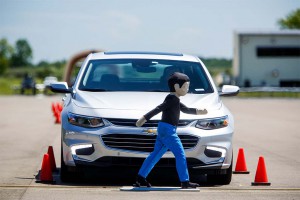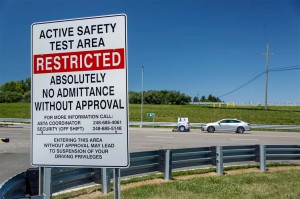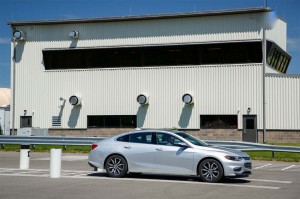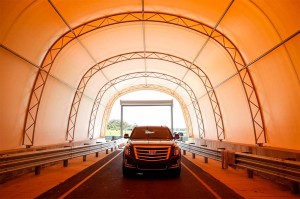As the big Chevrolet sedan races down the asphalt the driver seemingly misses the young boy who steps out on to the pavement. But his car doesn’t. An artificial vision system not only spots the pedestrian but slams on the brakes, stopping just a few feet before what might have been a deadly impact.
In fact, the demonstration run out at the General Motors Proving Grounds in Milford, Michigan used a pint-sized dummy rather than risking an actual child, but it provided a clear look at a new technology that the maker plans to begin offering in 2016 on several models, including the new Chevy Malibu.
Front Pedestrian Braking is, in fact, one of 22 different crash-avoidance technologies GM says it will offer through its four North American brands next year. And It promises more will follow, some already under development at a 52-acre Active Safety Test Area carved out of the suburban Detroit engineering complex.
It’s all part of what said Jeff Boyer, vice president of GM Global Vehicle Safety, calls a “comprehensive safety strategy of helping customers before, during and after a crash.”
GM is by no means alone. Just this week, Honda announced it will launch a package of collision avoidance technologies, collectively dubbed Honda Sensing, on the 2016 Accord. Earlier this year, Toyota revealed it will offer a similar package of safety features on a number of its Toyota and Lexus-brand products for the coming year.
(For more on the new Honda Sensing system, Click Here.)
The goal is to “one day reach a world without collisions,” said Mark Reuss, General Motors’ global product development director. While there will always be unavoidable accidents, whether a bridge collapse, a tree falling in a storm or a drunk driver seemingly intent on causing a crash, a growing list of safety experts believe we’re approaching a time when highway fatalities can all but be eliminated.
According to GM’s Boyer, the maker divides up its safety efforts into three categories:
- Passive safety systems, like airbags, designed to reduce deaths and injuries in a crash;
- Post-crash systems, such as a new OnStar software program that can estimate the severity of a crash and advise authorities what sort of rescue gear to bring;
- But the most promising area, he and others believe, is in crash-avoidance technology meant to prevent an accident in the first place.
This includes such systems as Lane Departure Warning, which can alert a motorist who might inadvertently drift across the white line, or even nudge the car back into its lane. Blind Spot Monitoring can alert a driver to another vehicle not immediately visible in the mirrors. Forward Collision Warning can sound an alert if a motorist misses a potential frontal crash. More advanced systems can spot pedestrians, even bicyclists, as well as vehicles, and even bring the car safely to a stop.
These are “the building blocks of future highly automated and autonomous vehicles,” said Boyer.
Actually, the building blocks are new sonar, laser, radar and vision sensors. And, as with consumer electronics technologies, they’re rapidly dropping in price, noted GM product czar Reuss, who said that has brought the automotive industry to “an inflection point.”
(Click Here for more on the new Toyota and Lexus safety packages.)
Where industry planners long believed that safety didn’t sell, that mantra has been turned upside down, and makers like GM, Ford, Honda, Toyota, Mercedes-Benz and Hyundai are putting as much emphasis on safety technology as they do design, performance and fuel economy.
GM has invested $14 million to set up the new Active Safety Testing Area, or ASTA, at its Milford Proving Grounds. But that’s just for the facility itself, it has been rapidly ramping up its broader safety R&D budget – as have key competitors.
Consumers are getting the benefit – and rapidly. Prices are falling while technologies are showing up in more and more vehicles. A few years ago, Active Cruise Control – which can automatically hold to the pace of traffic – was a $2,000 option on some of the most expensive luxury cars. Now, it’s being added in with a suite of other features, including collision avoidance and blind-spot warning, which many manufacturers are offering for less than $1,000. And a growing list of models include such features as standard equipment.
“Technology has just huge potential for the future,” Mark Rosekind, the head of the National Highway Traffic Safety Administration, said during a visit to Detroit this week.
The agency is considering mandating some features – and in the nearer-term may give bonuses to companies that provide collision avoidance technology as part of its vehicle crash rating program, known as NCAP.
In an unusual turnabout, some automakers actually want new regulations, arguing that will help boost volumes, lower costs, and make it possible to offer crash avoidance technologies across the board.
“If we’re really on top of our regulatory game, it will become regulated,” said Reuss.
(Hidden killers? Concern grows over what happens as airbags age. Click Here for this exclusive report.)





I wonder how many real children they lost before coming up with the dummy?